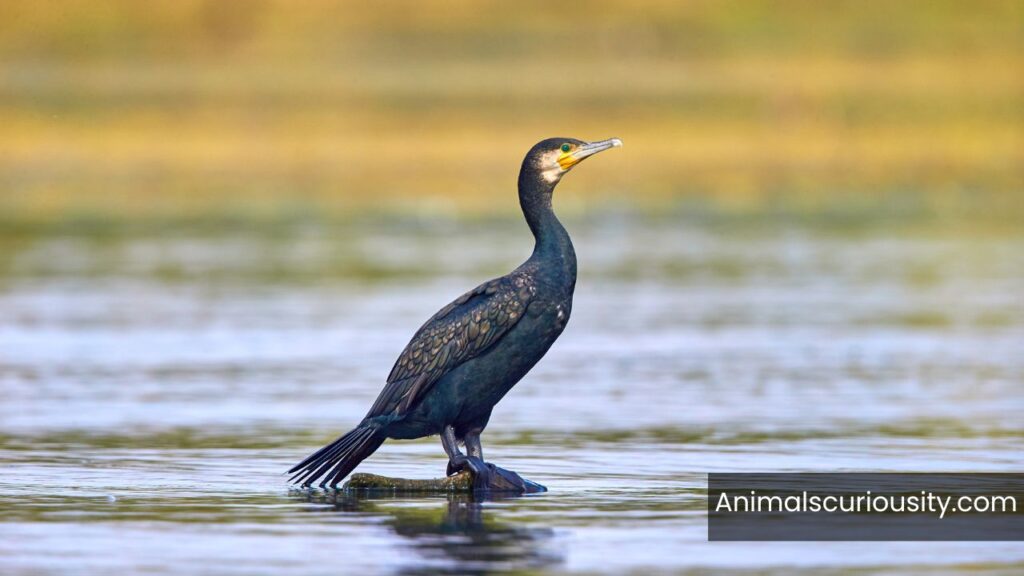Cormorants In Michigan (2 SPECIES )
As the sun rises over Michigan’s shimmering lakes, a black silhouette cuts through the morning mist, an elegant cormorant, wings outstretched as it dries in the golden light. These fascinating birds have become emblematic of Michigan’s diverse ecosystems, capturing the attention of birdwatchers and environmentalists alike.
With their striking appearance and captivating hunting techniques, cormorants are more than just another feathered resident; they are an essential part of our state’s ecological narrative.
Their presence has sparked a complex conversation among locals. While many revel in observing these skilled fishers gliding gracefully across the water’s surface, others voice concerns about their impact on fish populations and aquatic habitats.
In this article, we’ll dive into the life of cormorants in Michigan, exploring their unique adaptations, cultural significance, and the ongoing debates surrounding their conservation status. Join us as we unravel the mysteries behind these remarkable birds that continue to shape our understanding of Michigan’s natural world.
Species of Cormorants In Michigan
There are two types of cormorants in michigan:
- Double-crested Cormorant
- Neotropic Cormorant (Rare)
Double crested Cormorant Michigan

Identification
The Double-crested Cormorant, a striking waterbird found throughout Michigan, is easily identifiable by its sleek black body and distinctive double crest that becomes pronounced during the breeding season. These birds sport a sharp, hooked bill, ideal for catching fish in their aquatic habitats. When they come ashore to dry their wings, often with necks outstretched and wings unfurled, the contrast of their glossy plumage against the blue sky creates a mesmerizing sight.
Spotting these cormorants along Michigan’s lakes and rivers provides an opportunity to appreciate their unique behavior. They are masterful divers, plunging to depths of up to 25 feet in pursuit of fish, demonstrating remarkable agility underwater. As they dive and surface with ease, witnessing this predatory dance unveils a side of nature rarely seen up close.
Range
The double-crested cormorant, a striking black bird with distinctive orange-yellow skin under its throat, has carved a niche for itself across Michigan’s diverse waterways. Known for their exceptional diving skills, these birds deftly pursue fish underwater, often leaving onlookers in awe of their hunting prowess. Their expanding range in the Great Lakes region has sparked both admiration and concern among local communities; while many appreciate their role as indicators of aquatic biodiversity, others worry about the impacts they have on fish populations.
Interestingly, the cormorant’s adaptability to changing environments showcases nature’s resilience. As water temperatures rise and ecosystems shift due to climate change, these birds have begun to venture further inland – utilizing lakes and rivers beyond traditional nesting sites. This expansion illustrates not just survival but an opportunistic nature that can serve as a critical barometer for environmental health.
Diet and Foraging Habits
Double-crested cormorants are fascinating birds that thrive in Michigan’s diverse aquatic ecosystems. Their diet primarily consists of fish, but they have a particular preference for species such as yellow perch and alewives. Equipped with sharp vision and agile swimming abilities, these birds dive beneath the water’s surface to hunt, often submerging for up to 30 seconds while pursuing their prey. This impressive hunting technique not only demonstrates their adaptability but also highlights their role in maintaining the balance of local fish populations.

Readmore: Vultures OF Michigan.
What sets cormorants apart is their unique foraging behavior. Unlike many other birds, they often forage in groups, creating a dynamic feeding frenzy that can displace schools of fish. This cooperative strategy increases their fishing efficiency and showcases a level of social interaction rarely seen in avian species. They have been known to congregate around human-made structures like docks or marinas, where fish are attracted by underwater disturbances , a testament to their opportunistic nature.
Where to Find This Bird
Double-crested cormorants are a fascinating sight along Michigan’s scenic waterways, especially during the migration seasons. These striking birds can often be spotted perched on shorelines or diving into the depths of lakes and rivers in search of fish. To truly experience their presence, head to Lake Michigan’s coastal areas, where they gather in impressive numbers. Look for them around Grand Traverse Bay or on the islands of the Sleeping Bear Dunes, perfect locations for both birdwatching and photography.
Another remarkable spot is Saginaw Bay, teeming with aquatic life that attracts these agile hunters. As you explore wetlands like those at Pointe Mouillee State Game Area, listen for their distinctive calls echoing through lush surroundings. Early mornings or late afternoons provide prime viewing times when cormorants are often seen drying their wings after a successful fishing spree.
Neotropic Cormorant (Rare)

Also read: CRANES IN MICHIGAN.
Identification
Identifying the Neotropic Cormorant in Michigan can be an exhilarating challenge for birdwatchers and nature enthusiasts. Unlike its more common cousin, the Double-crested Cormorant, which is prevalent across numerous waterways, the Neotropic Cormorant is a rare sight in this region.
One of the distinguishing features of the Neotropic is its strikingly sleek profile and a slightly smaller stature, typically measuring about 26 to 30 inches long. When observing their plumage, look for a dark, glossy appearance with subtle shades of brown or green when they catch the sunlight, a stunning display that sets them apart from other cormorants.
Range
In Michigan, the Neotropic Cormorant has steadily extended its range, adding a vibrant chapter to the state’s avifauna. Unlike its more common cousin, the Double-crested Cormorant, the Neotropic Cormorant is often found in warmer climates but has made its way to Michigan’s wetlands and lakesides. Birdwatchers are now discovering these striking birds with their sleek bodies and distinctive buff-colored facial features against a backdrop of lush vegetation.
Diet and Foraging Habits
Neotropic Cormorants, although often overshadowed by their more common double-crested cousins, exhibit fascinating foraging habits that set them apart. They are skilled divers, capable of plunging to depths of over 20 feet in pursuit of fish. What makes them particularly intriguing is their preference for smaller freshwater fish, like shad and sunfish, which they capture with remarkable agility. Their hunting strategy revolves around cooperative behavior; these birds have been observed working together to corral schools of fish into tight balls before diving in for a feast.

Also read: Are There Badgers In Michigan?
An engaging aspect of the Neotropic Cormorant’s diet lies in its adaptability to fluctuating environmental conditions. During certain seasons or periods when local fish populations dwindle, they expand their menu to include crustaceans and amphibians, showcasing a remarkable flexibility that underscores their role as opportunistic feeders. The cormorants’ foraging patterns are influenced by habitat changes, shallow lakes and marshes becoming hotspots when larger bodies of water experience declines in visibility due to algae blooms or other disturbances.
Where to Find This Bird
Neotropic cormorants, with their striking plumage and distinctive silhouettes, are a fascinating sight along Michigan’s waterways. While commonly found in the southern United States, these birds have been expanding their range northward, making encounters in Michigan increasingly likely.
To catch a glimpse of these elegant divers, head to areas like the Saginaw Bay or along the shores of Lake Erie where they often congregate in flocks. Their presence can also be spotted at local wildlife refuges such as the Pointe Mouillee State Game Area, especially during migration seasons.
Observing neotropic cormorants offers more than just birdwatching; it’s a window into a fragile ecosystem evolving due to climate change and habitat shifts. One might notice them perched on trees or reclaiming sticks for nesting near water bodies, an intriguing behavior that highlights their adaptability.
Readmore: Explore Animals That Waddle.
Summary
Cormorants play a significant role in Michigan’s ecosystems, exhibiting both their beauty and ecological importance. As they continue to thrive in various habitats across the state, understanding their behavior and impact is crucial for maintaining biodiversity. Conservation efforts are necessary to balance their presence with the needs of local fish populations and recreational activities.
By fostering awareness about these remarkable birds, we can promote coexistence that benefits both wildlife and communities. Let’s take action to protect our natural resources while appreciating the unique contributions of cormorants to Michigan’s environment.
FAQs
Are cormorants native to michigan?
Yes, cormorants are native to Michigan. The double-crested cormorant, in particular, is commonly found in the Great Lakes region, including Michigan’s lakes and rivers. These birds thrive in aquatic environments and are often seen diving for fish.
What is the rarest bird in Michigan?
The rarest bird in Michigan is often considered to be the Kirtland’s Warbler. This small, songbird species is primarily found in young jack pine forests and has a very limited breeding range. Once on the brink of extinction due to habitat loss, conservation efforts have helped stabilize its population, though it remains a rare sight.
- Discover Top 9 White Birds in Florida (With Pictures) - November 7, 2024
- Discover Top 16 Black Birds In South Carolina (With Pictures) - November 6, 2024
- Explore Top 18 Most Famous Yellow Birds in Arizona (With Pictures) - November 5, 2024







